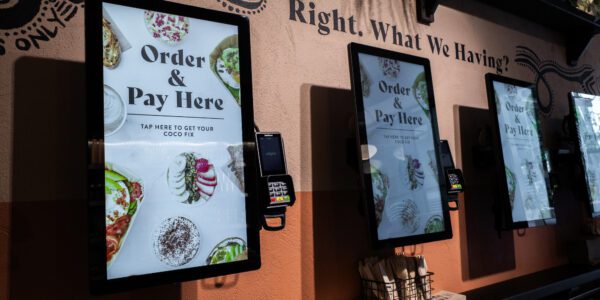Seven incredible benefits of using self service kiosks
Self serve kiosks aren’t just for McDonalds any more. Discover the financial and operational benefits of kiosks and why they might be right for your restaurant.

Self service kiosks are the future of restaurant tech. Customers love them and they’re great for operators too. Fast food giants like McDonald’s, KFC and Burger King have all seen huge success since installing self service kiosks. It’s this widespread adoption of tech that has drastically changed the way we order food and drink over the past decade.
For restaurant operators considering self serve kiosks, it can be hard to know where to start, let alone how to incorporate them as part of your wider strategy. “Which kiosk provider should I use? What hardware do I need? How many kiosks should I install? How do I make sure my customers actually use them?” These are all common questions that we get asked at Vita Mojo.
This blog outlines the key considerations you should make when choosing self service kiosks for your restaurant. Follow these four simple steps to ensure you get the best value from your self serve kiosk technology.
Digital transformation might sound like an overwhelming concept, but it really doesn’t have to be. We’ve broken down the buying and implementation process into four key steps: software, hardware, space planning and order fulfilment. Let’s take a closer look at each one.
Choosing the right restaurant technology has historically been a hardware-led decision but as hardware is becoming cheaper and more standardised, it’s increasingly what’s on the inside your kiosk that really counts – your software. Choosing the right software provider for your kiosks will have the most influence on the quality of your customer experience, your flexibility in making kiosks work within your restaurant operations, and the overall success of your kiosks.
– Integrate with your kiosk software with your POS and other ordering channels, so you can gather holistic sales data and maximise operational efficiencies in your back-of-house too.
A good kiosk provider will offer hardware that’s fully customisable, including colours, styling, payments and configuration options. As well as aesthetics, consider your hardware in terms of the problems it solves for you and your customers. Ask yourself:
In total, a standard kiosk’s hardware tends to work out at £1000 to £1500, including the screen, stand, wall mount, ePDQ and other core hardware. With three kiosks, a high footfall QSR can expect to see these costs covered after just one month. Even so, this is significant capital investment – particularly when multiplied across several sites. For this reason, it’s best to prioritise your highest footfall locations and rollout gradually to trial your kiosk choices and spread your hardware costs over time.

One factor that is often overlooked by operators is the physical placement of the kiosks. Where you position your kiosks within your restaurant venues can have a major impact on customer uptake, which directly affects your bottom line. Testing out various locations and signage options is paramount to optimise your customer journey. Your site flow should direct customers towards your kiosks and encourage them to order for themselves rather than joining a queue for the till.

Figuring out self service kiosks can be complex and overwhelming. That’s why it pays off to look for a software provider who has experience with this process, and can provide consultancy, as well as technology, to support you on your digital journey.
Top tip:– Be open to try things, make operational improvements and keep adjusting to maximise the benefits for your customers, your staff and your business. It might feel like a lot of effort, but if you implement kiosks thoughtfully and effectively, the return on investment will make it all worth it.
Self serve kiosks aren’t just for McDonalds any more. Discover the financial and operational benefits of kiosks and why they might be right for your restaurant.

From tech audits, to productivity tools, to full scale roll-outs of transformative tech, let’s take a look at real life cost-reducing examples of tech in the industry.

What if we view rising labour costs as a catalyst for positive change instead of a threat, asks Stefan Catoui, co-founder of Vita Mojo.
